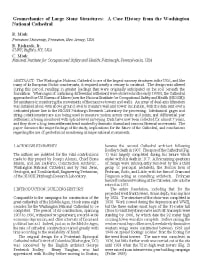Mining Publication: Geomechanics of Large Stone Structures: A Case History From the Washington National Cathedral
Original creation date: July 2001
Authors: C Mark, R Richards, C Mark
NIOSHTIC2 Number: 20022903
Rock Mechanics in the National Interest. Vol. II, Lisse, Netherlands: A. A. Balkema, 2001 Jul; 2:1055-1061
The Washington National Cathedral is one of the largest masonry structures in the USA, and like many of its European Gothic counterparts, it required nearly a century to construct. The design was altered during this period, resulting in greater loadings than were originally anticipated on the soil beneath the foundation. When signs of continuing differential settlement were observed in the early 1990's, the Cathedral approached the US Bureau of Mines--now the National Institute for Occupational Safety and Health (NIOSH)--for assistance in monitoring the movements of the massive towers and walls. An array of dual-axis tiltmeters was installed about 40m above ground level to measure wall and tower inclination, with the data sent over a dedicated phone line to the NIOSH Pittsburgh Research Laboratory for processing. Mechanical gages and string-potentiometers are also being used to measure motion across cracks and joints, and differential pier settlement is being monitored with optical-level surveying. Data have now been collected for almost 7 years, and they show a long-term settlement trend masked by dramatic diurnal and seasonal thermal movements. The paper discusses the major findings of the study, implications for the future of the Cathedral, and conclusions regarding the use of geotechnical monitoring at major national monuments.

NIOSHTIC2 Number: 20022903
Rock Mechanics in the National Interest. Vol. II, Lisse, Netherlands: A. A. Balkema, 2001 Jul; 2:1055-1061